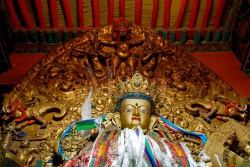Batuo
The Indian Dhyana master Buddhabhadra (Chinese: 跋陀; pinyin: Bátuó) was the first abbot of Shaolin Monastery.
Former Worthies Gather at the Mount Shuang-feng Stūpa and Each Talks of the Dark Principle contains the following reference to him:
Dhyana Master Buddha says: "The extreme principle is wordless.
The sagely Mind is unimpeded." (Broughton 1999:108)
According to the Deng Feng County Recording (Deng Feng Xian Zhi), Bátuó came to China in 464 CE and preached Nikaya (小乘) Buddhism for thirty years.
Thirty-one years later, in 495, the Shaolin Monastery was built by the Order of Emperor Xiaowen of Northern Wei for Batuo's preaching.
Bátuó's disciples Sengchou[1] and Huiguang were both expert in the martial arts by the Time they began their studies of Religion with Batuo.
Batuo (Buddhabhadra, Shaolin Abbot) was a Buddhist monk from Indian.
He carried forward Buddhism to China during the Emperor Xiaowen reign of the Northern Wei Dynasty (around 490 A.D.) and was well received and highly respected.
As master Batuo preferred a place of tranquility, Emperor Xiaowen established a temple for him in the Shaoshi woods, Mount Song, namely Shaolin Temple.
Therefore, Batuo became the founder and the first abbot of Shaolin Temple.
During his stay, Batuo had contributed a lot to Buddhist scripture translation into Chinese, including the Avatamsaka Sutra, the Mahaparinirvana Sutra, the Vimalakirti Sutra and the Dasabhumika Sutra, etc.
Batuo’s most prominent disciples who followed the Hinayana teaching and guidance include Huiguang and Sengchou.
